
Ticonderoga is a town in Essex County, New York, United States. The population was 5,042 at the 2010 census. The name comes from the Mohawk tekontaró:ken, meaning "it is at the junction of two waterways".

Liberty Island is a federally owned island in Upper New York Bay in the United States. Its most notable feature is the Statue of Liberty, a large statue by Frédéric Auguste Bartholdi that was dedicated in 1886. The island also contains the Statue of Liberty Museum, which opened in 2019 and exhibits the statue's original torch.
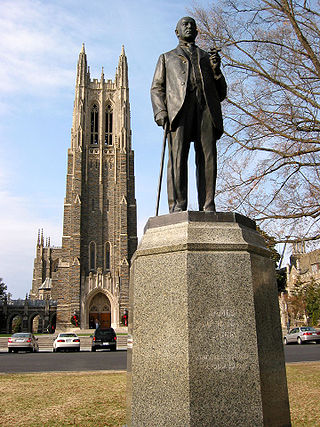
Charles Keck was an American sculptor from New York City, New York.
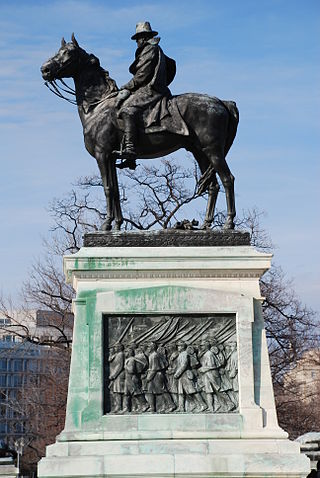
The Ulysses S. Grant Memorial is a presidential memorial in Washington, D.C., honoring American Civil War general and 18th United States President Ulysses S. Grant. It sits at the base of Capitol Hill, below the west front of the United States Capitol. Its central sculpture of Grant on horseback faces west, overlooking the Capitol Reflecting Pool and facing toward the Lincoln Memorial, which honors Grant's wartime president, Abraham Lincoln. Grant's statue is raised on a pedestal decorated with bronze reliefs of the infantry; flanking pedestals hold statues of protective lions and bronze representations of the Union cavalry and artillery. The whole is connected with marble covered platforms, balustrades, and stairs. The Grant and Lincoln memorials define the eastern and western ends, respectively, of the National Mall.

The Statue of Liberty National Monument is a United States National Monument comprising Liberty Island and Ellis Island in the U.S. states of New Jersey and New York. It includes the 1886 Statue of Liberty by sculptor Frédéric Auguste Bartholdi and the Statue of Liberty Museum, both situated on Liberty Island, as well as the former immigration station at Ellis Island which includes the Ellis Island Immigrant Hospital.

The Peace Monument, also known as the Naval Monument or Civil War Sailors Monument, stands on the grounds of the United States Capitol in Peace Circle at First Street, N.W., and Pennsylvania Avenue, Washington, D.C. The 44 foot high white marble memorial was erected from 1877 to 1878 in commemoration of the naval deaths at sea during the American Civil War. Today it stands as part of a three-part sculptural group including the James A. Garfield Monument and the Ulysses S. Grant Memorial.

The steamboat Ticonderoga is one of two remaining side-paddle-wheel passenger steamers with a vertical beam engine of the type that provided freight and passenger service on America's bays, lakes and rivers from the early 19th to the mid-20th centuries. Commissioned by the Champlain Transportation Company, Ticonderoga was built in 1906 at the Shelburne Shipyard in Shelburne, Vermont on Lake Champlain.

The Princeton Battle Monument is located in Princeton, New Jersey, adjacent to Morven and Princeton's borough hall. The monument commemorates the January 3, 1777 Battle of Princeton, and depicts General George Washington leading his troops to victory and the death of General Hugh Mercer. It stands 50 feet (15 m) tall and was inspired by carvings on the Arc de Triomphe in Paris. Designed to visually anchor the western end of Nassau Street, the monument and its park are a legacy of the City Beautiful movement.
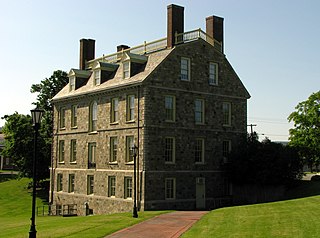
The Hancock House is an historic structure in Ticonderoga, New York. It is a replica of the Hancock Manor on Boston's Beacon Hill that was the residence of Thomas Hancock, the uncle of Founding Father John Hancock.

Liberty Arming the Patriot, sometimes called Freedom Arming the Patriot, is a bronze sculpture at Park Place in Pawtucket, Rhode Island, commemorating the participation of the city's citizens in the American Civil War. It was designed by William Granville Hastings and cast by the Gorham Manufacturing Company in 1897. Unlike many Civil War memorials, Liberty Arming the Patriot is a dynamic composition, depicting a young farmer setting his plow aside, and reaching to take a sword from a classical female figure clad in breastplate and wielding a pike. The statue is 11 feet (3.4 m) in height, and is mounted on a granite base 10 feet (3.0 m) high and 22 feet (6.7 m) wide. The sculpture was listed on the National Register of Historic Places in 2001.
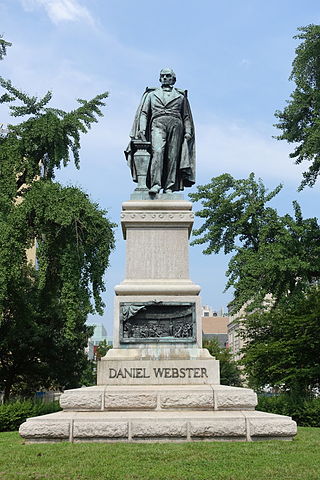
The Daniel Webster Memorial is a monument in Washington, D.C. honoring U.S. statesman Daniel Webster. It is located near Webster's former home at 1603 Massachusetts Avenue Northwest, beside Scott Circle at the intersection of Massachusetts Avenue and Rhode Island Avenue.
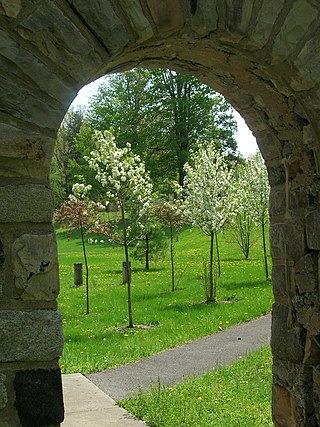
Utica Parks and Parkway Historic District is a national historic district located at Utica in Oneida County, New York. It consists of four contributing historic elements: a historic right-of-way known as the Memorial Parkway and the three large parks it connects: Roscoe Conkling Park, F.T. Proctor Park, and T.R. Proctor Park. The district includes seven contributing buildings, three contributing sites, 26 contributing structures, and five contributing objects. The park and parkway system was designed between 1908 and 1914 by the firm of Olmsted Brothers Landscape Associates, headed by Frederick Law Olmsted Jr. The Utica Zoo is located in Roscoe Conkling Park.
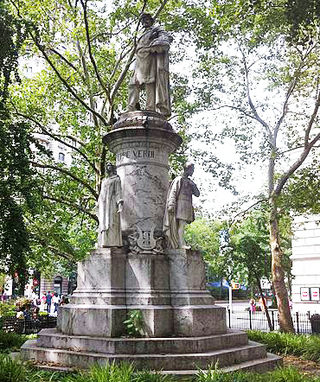
The Giuseppe Verdi Monument is a sculpture honoring composer Giuseppe Verdi in Verdi Square Park in Manhattan, New York City. The statue was created by Italian sculptor Pasquale Civiletti.
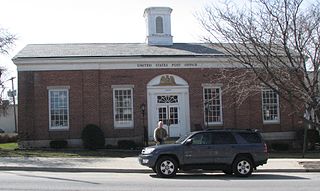
US Post Office-Ticonderoga is a historic post office building located at Ticonderoga in Essex County, New York, United States. It was designed and built in 1936–37, and is one of a number of post offices in New York State designed by the Office of the Supervising Architect of the Treasury Department under Louis A. Simon. The building is in the Colonial Revival style and is a symmetrically massed, one story brick building with a stone watertable. The slate covered gable roof is topped by a square, flat-topped cupola with Doric order pilasters. The interior features a 1940 mural by Frederick Massa titled The Exhortation of Ethan Allen.
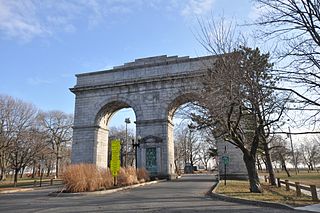
Seaside Park, located in Bridgeport, Connecticut, is a 2.5-mile (4.0 km) long crescent-shaped park bordering Bridgeport Harbor, Long Island Sound, and Black Rock Harbor. The park lies within Bridgeport's South End neighborhood.

Major General Comte Jean de Rochambeau is a bronze statue by Fernand Hamar which honors Jean-Baptiste Donatien de Vimeur, comte de Rochambeau, a French nobleman and general who played a major role in helping the Thirteen Colonies win independence during the American Revolution.

Captain Nathan Hale is a bronze statue of Nathan Hale, by Bela Lyon Pratt. It is located at the south facade of the Robert F. Kennedy Department of Justice Building, 10th Street and Constitution Avenue, Northwest, Washington, D.C.

The Robert E. Lee Monument was an outdoor bronze equestrian statue of Confederate general Robert E. Lee and his horse Traveller located in Charlottesville, Virginia's Market Street Park in the Charlottesville and Albemarle County Courthouse Historic District. The statue was commissioned in 1917 and dedicated in 1924, and in 1997 was listed on the National Register of Historic Places. It was removed on July 10, 2021.

Pedimental sculptures are sculptures within the frame of a pediment on the exterior of a building, some examples of which can be found in the United States. Pedimental sculpture pose special challenges to sculptors: the triangular composition limits the choices for figures or ornament at the ends, and the sculpture must be designed to be viewed both from below and from a distance.


















